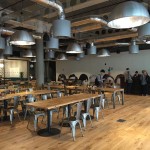 In our post-pandemic world, there is a growing desire for “third places” that facilitate remote working but aren’t our actual homes. As with many things Covid-related, this is a continuation of a trend that was already emerging. For instance, research before the pandemic showed that a growing number of cafes are specifically tailoring their offering to digital nomads who can work from anywhere. For instance, power sockets were found to be crucial, and often more important than the actual coffee itself.
In our post-pandemic world, there is a growing desire for “third places” that facilitate remote working but aren’t our actual homes. As with many things Covid-related, this is a continuation of a trend that was already emerging. For instance, research before the pandemic showed that a growing number of cafes are specifically tailoring their offering to digital nomads who can work from anywhere. For instance, power sockets were found to be crucial, and often more important than the actual coffee itself.
The study found that the social aspect of working in a cafe was vitally important to workers, who revealed that it made them feel a part of something bigger, while the background noise also bolstered their creativity levels.
This was verified by a study, which found that the low-level background noise you often find in a coffee shop can be beneficial, especially to our creative thinking. What’s more, the fact that we’re surrounded by people working hard can spur us on to greater efforts. Another study went as far as to suggest that being surrounded by others beavering away can provoke greater effort in ourselves.
Couple this with a welcoming, yet flexible environment, and it’s perhaps not surprising that more and more of us are choosing the friendly and social option of working in a cafe rather than the solitary existence of working at home.
Workplace design
The growing allure of cafes as a place to work has prompted many employers to try and tap into their design features and transform workplaces to be more welcoming and also creative. The last few years have seen the likes of games rooms and sleeping pods become more commonplace.
In addition to being fun places to be, these environments are supposed to encourage creativity, collaboration, and innovation. Recent research from INSEAD explores whether this is really the case.
The researchers utilized the Creative Garage, which is a space in INSEAD’s Singapore campus that has many of the trappings found in a modern workplace, such as whiteboard walls, bright cushions, and the shabby chic look common in many a co-working space.
Unconventional space
Obviously what is deemed to be unconventional is often in the eye of the beholder, so the researchers wanted to ensure that this was the case for the participants in their research, all of whom reported that they found the Creative Garage unconventional. The researchers hoped that this would trigger more divergent thinking and the generation of new ideas.
Surprisingly, however, the volunteers who completed a creative task in the Creative Garage actually came up with less creative ideas than their peers operating in a more conventional workspace. When the researchers analyzed why this was, it emerged that people in the unconventional space became fixated on particular ideas inspired by their surroundings, which then limited their ability to concoct truly novel solutions.
The results highlight that it would be a mistake to assume that having a quirky and unconventional workplace is going to be the silver bullet for creativity among the workforce, and creativity is rather more nuanced than that. Indeed, an unconventional workplace can lead to lower levels of creativity if employees are “inspired” by their surroundings and get fixated on the ideas that emerge from that inspiration.
As organizations are looking at ways to get employees back into the workplace, there is an understandable desire to make the built environment as attractive as possible. If managers succumb to this temptation, then the research suggests that any quirkiness in the design of the workplace should be as unrelated to any tasks performed within it as possible. At least, that’s if they want to encourage creativity within the workforce.